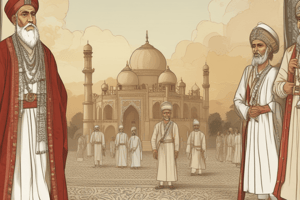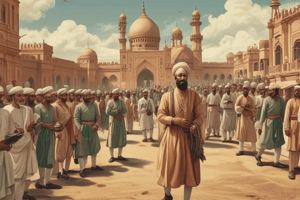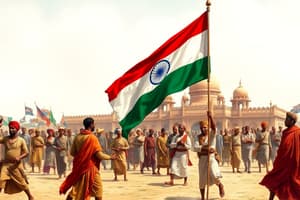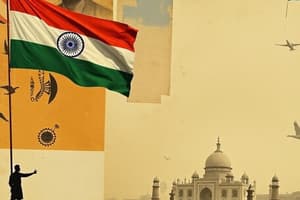Podcast
Questions and Answers
What was the primary ideology behind the Indian Independence Movement?
What was the primary ideology behind the Indian Independence Movement?
- British imperialism
- Indian nationalism (correct)
- Marxism
- Socialism
Which event is characterized by the boycott of British goods and the promotion of Indian industries?
Which event is characterized by the boycott of British goods and the promotion of Indian industries?
- Non-Cooperation Movement
- Salt March
- Quit India Movement
- Swadeshi Movement (correct)
Who were some of the early leaders of the Indian Independence Movement?
Who were some of the early leaders of the Indian Independence Movement?
- Mahatma Gandhi and Bal Gangadhar Tilak
- Sardar Patel and B. R. Ambedkar
- Ram Mohan Roy, Dadabhai Naoroji, and Bal Gangadhar Tilak (correct)
- Jawaharlal Nehru and Muhammad Ali Jinnah
What significant action did Mahatma Gandhi lead in 1930?
What significant action did Mahatma Gandhi lead in 1930?
In what year did India gain independence from British rule?
In what year did India gain independence from British rule?
What was the outcome of the demand made by the Muslim League under Muhammad Ali Jinnah?
What was the outcome of the demand made by the Muslim League under Muhammad Ali Jinnah?
When did India adopt its Constitution and become a republic?
When did India adopt its Constitution and become a republic?
Who was the first Prime Minister of India?
Who was the first Prime Minister of India?
Flashcards are hidden until you start studying
Study Notes
Background
- India was a British colony from the mid-18th century until 1947
- British East India Company established trade relations with India in the early 17th century
- Over time, the company's influence expanded, and India became a British colony
Indian Independence Movement
- Emerged in the late 19th century, with Indian nationalism as its core ideology
- Early leaders included Ram Mohan Roy, Dadabhai Naoroji, and Bal Gangadhar Tilak
- Movement gained momentum in the early 20th century with the leadership of Mahatma Gandhi
Key Events
- Swadeshi Movement (1905-1908): boycott of British goods and promotion of Indian industries
- Non-Cooperation Movement (1920-1922): mass protests and civil disobedience against British rule
- Salt March (1930): Gandhi-led march to protest the British salt tax
- Quit India Movement (1942-1944): demand for immediate independence from British rule
Indian National Congress
- Founded in 1885, became the primary voice of Indian nationalism
- Led by Gandhi, Nehru, and Patel, among others
- Demanded independence, constitutional reforms, and protection of Indian rights
Muslim-Hindu Divide and the Creation of Pakistan
- Muslim League, led by Muhammad Ali Jinnah, demanded a separate homeland for Muslims
- 1947: British government divided British India into India and Pakistan
- Mass migration and violence occurred during the partition
Independence and Aftermath
- August 15, 1947: India gained independence
- January 26, 1950: India adopted its Constitution, becoming a republic
- Jawaharlal Nehru: first Prime Minister of India
- Mahatma Gandhi: assassinated on January 30, 1948
Colonial India
- British colonization of India lasted from the mid-18th century until 1947.
- The British East India Company initiated trade with India in the early 17th century, expanding influence over time.
Indian Independence Movement
- The movement, centered on Indian nationalism, began in the late 19th century.
- Early leaders included:
- Ram Mohan Roy: Pioneer of social and religious reform.
- Dadabhai Naoroji: Advocated for Indian rights and education.
- Bal Gangadhar Tilak: Early proponent of self-rule.
- Mahatma Gandhi became a significant figure in the early 20th century, promoting non-violent resistance.
Key Events in the Movement
- Swadeshi Movement (1905-1908): Encouraged the boycott of British products to boost Indian industries.
- Non-Cooperation Movement (1920-1922): Sparked mass protests and active refusal to obey British laws.
- Salt March (1930): A 240-mile march led by Gandhi to oppose the British salt tax, symbolizing civil disobedience.
- Quit India Movement (1942-1944): A significant call for immediate independence from British domination.
Indian National Congress
- Established in 1885, it became the leading organization for Indian independence.
- Major figures included Gandhi, Jawaharlal Nehru, and Sardar Vallabhbhai Patel.
- Advocated for independence, constitutional reforms, and the rights of Indians.
Muslim-Hindu Divide and Pakistan's Formation
- The Muslim League, under Muhammad Ali Jinnah, sought a separate nation for Muslims.
- The partition of British India in 1947 resulted in the establishment of India and Pakistan.
- This division led to mass migrations and widespread communal violence.
Independence and Its Aftermath
- August 15, 1947: India officially gained independence from British rule.
- January 26, 1950: India adopted its Constitution, declaring itself a republic.
- Jawaharlal Nehru became the first Prime Minister, emphasizing unity and progress.
- Mahatma Gandhi was assassinated on January 30, 1948, impacting the nation's symbol of peace and non-violence.
Studying That Suits You
Use AI to generate personalized quizzes and flashcards to suit your learning preferences.




